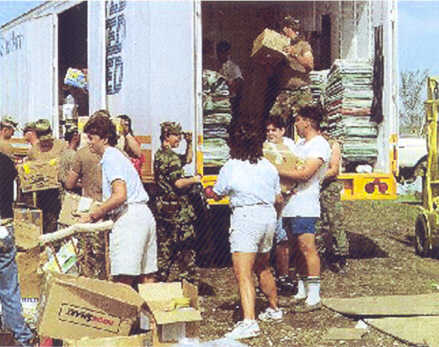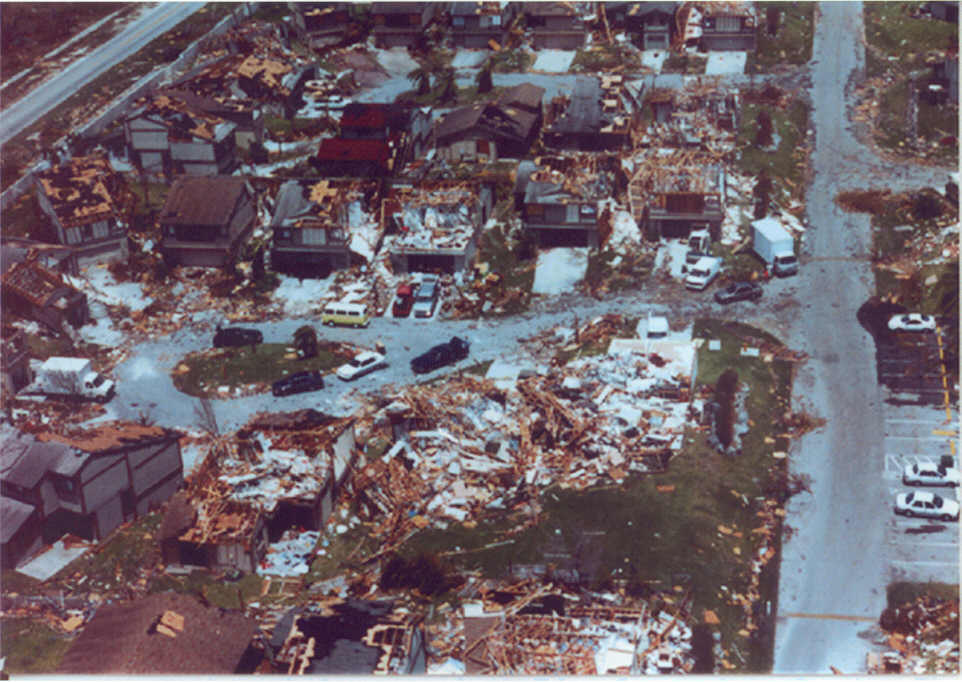![]() 1st Battalion 22nd Infantry
1st Battalion 22nd Infantry ![]()
Hurricane Andrew August 1992

Soldiers and civilians work together to distribute relief supplies in the aftermath of Hurricane Andrew
At 0500 hours, 24 August 1992, Hurricane Andrew, a category four hurricane, crashed through southern Florida, devastating the town of Homestead, Homestead Air Force Base, Florida City and the surrounding areas. Its maximum sustained winds were 145 miles per hour and gusts up to 175 miles per hour were recorded. It was one of the three most devastating hurricanes to hit the United States in the twentieth century and is thought to have been the most damaging hurricane on record in terms of property damage and total cost.
The total cost in damages reached over 12 billion dollars. The death toll stood at 41. The 1st Battalion 22nd Infantry, and all of the 10th Mountain Division formed a portion of the Army Forces (ARFOR) of Joint Task Force Andrew (JTF Andrew). Altogether some 22,000 military personnel were involved in the relief efforts, making it the largest operation of its kind in US history.
The first views of the damage from the storm for the soldiers of 1/22 Infantry came as the battalion deplaned on August 30, 1992, at Homestead Air Force Base and embarked on busses towards the then unbuilt First Brigade base camp. Hangars were torn open, C-130 cargo planes and F16 fighters were flipped over and strewn about as if they were toys. The 1st Battalion 22nd Infantry soldiers could see that their work was cut out for them and they could also begin to understand the "why" behind their deployment.
While the battalion set up a base camp in the vicinity of the outskirts of Homestead, Florida, key leaders and staff reconnoitered the local area where the battalion would be conducting its mission. The city was divided into zones by streets and geographic areas among all of the battalions of the first brigade in the same fashion as other units of the division. The initial reconnaisance revealed the complete devastation that the poeple of the Homestead area had endured with the passage of the hurricane. Only major streets and highways had any of the debris cleared off of them and all other roads were blocked with trash and debris. Roofs had been blown off of buildings, and telephone and light poles had been blown over. Power and lights were off in all parts of the district, and potable water and food was unavailable.
After the reconnaisance operations, the battalion commander and staff devised their plan to alleviate the problems in the assigned area of operations (AO). The plan divided the battalion sector into company zones that were then marked on acetate graphics, overlaid on the Homestead, Florida map. Each company then divided its sectors into platoon areas of operations and each of the leaders was assigned general cleanup tasks. First priority went to removal of anything that would cause a health hazard, either to a soldier or civilian, followed by food distribution. The third priority was concentration on large debris removal. Lastly, leaders would follow through by asking the residents what it was that they needed help with to get their lives back in order.
Each unit would spend the daylight hours deployed into their assigned sectors removing debris and assisting the local population as necessary. Special equipment, whether deployed with the unit or purchased, was critical to speeding the recovery effort. The handsaws that were deployed in the squad boxes, and the purchased chain saws were of particular benefit.
In addition to soldier labor in each neighborhood, the battalion was also responsible for oversight of several feeding sites, Mobile Kitchen Trailer Operations (MKT), the placement and maintenance of porta-potties, and the placement and emptying of large trash dumpsters. The MKT operations were manned by support units from outside of 1/22 Infantry. Just under 900,000 meals were served off of MKTs for the first thirty-three days of the operation. The porta-potties and dumpsters were contracted relief initiatives that also became reporting criteria based on location within a unit's AO.
As the cleanup effort got underway, the JTF and division staffs developed a means to measure success of the operation. The basic premise was that as each sector was cleared of debris and as civilian life was returned to a more normal state, that sector was deemed completed. To measure this, statistics of all types were collected and reported by local commanders to their higher headquarters. (Some examples of reported information were the number of dump truck loads to the dump, the number of meals served at an NKT per day, or the number of dumpsters emptied daily). This push of information and reporting naturally resulted in a tendency by units to compete in clearing their assigned areas faster than other units. Competition bred the need for units to lead the "race" towards mission accomplishment.
The 1st Battalion 22nd Infantry proved it could produce results as well as other units; that was the nature of the command climate: win any and all competitions and uphold the lineage of the unit, no matter what the mission.
One primary focus for some of the battalion's senior leaders in the race to clean areas and declare them "cleared" came in the form of material handling equipment (MHE), such as bulldozers and dump trucks. A light infantry battalion is very limited in the amount of heavy wheeled vehicles it has to apply to a mission such as debris removal. Piles of cut trees and trash moved by hand to the sides of the road or an intersection did not constitute a cleared area. Only after all of the gathered piles had made it to the designated dump sight was the area considered "cleared". The contracting of civilian dump trucks to support military units was the answer to the lack of MHE. However, the dump trucks companies and their drivers did not understand an even and fair division of trucks per working unit; they only recognized the military officer or NCO who controlled his truck. The resourceful unit and commander "commandeered" as many dump trucks as possible to clear assigned sectors faster. This became the daily ritual for the staff and company commanders -- get as many trucks as possible and keep them as long as possible. This phenomenon was a potential detriment to any unit's mission accomplishment for the assigned day's task -- that is if enough trucks were not secured.
As time and the mission progressed, and the destroyed areas improved, each unit's sector was ranked in terms of the amount of work still to be completed (waste and trash removal) and how much had been accomplished, and this was again reported in terms of percentage. Each sector was reported on daily by the commander who owned that sector to the next higher headquarters. These reports eventually translated into measurable graphics on how well the JTF and its subordinate units were doing in terms of providing relief.
By mid-September 1992, civilian reflief agencies began to control more of the relief missions and therefore relieved military units of their responsibilities. Due to this reduction in workload for military units, there was no need to maintain such a large military force with little or no work. The first unit of the JTF to redeploy was the 82nd Airborne Division. With the loss of that division, efforts of the 10th Mountain Division and First Brigade were expanded north to encompass a larger area of operations. The move north occurred as a relief in place operation much in the same way as a relief would occur in a combat situation.
As life improved for the local population, the improvement manifested itself in local self-sustainment without military assistance. During the last week of September 1992, 1/22 Infantry no longer deployed into the neighborhoods of the Homestead area, but instead concentrated on redeployment activities. The battalion redeployed back to Fort Drum, New York, on or about 7 October, 1992, after serving in Hurricane Andrew relief for some forty consecutive days.
The After-Action Reviews of the deployment emphasized three main themes:
The first was that a light infantry battalion, well trained in its combat tasks, could perform any assigned mission, combat or humanitarian, even if it was not perfectly suited for the job.
Secondly, in regard to the combat training tasks, if a unit, regardless of its level ( squad through company ), could execute intense and stressful live fire training, then it would be prepared for any action, whether combat or something less than combat.
The third theme was that the family support group and its functions were key to the unit's success in the deployment.

Devastation caused by Hurricane Andrew
Most of the above article was edited from:
TASK FORCE 1-22 INFANTRY FROM HOMESTEAD TO PORT-AU-PRINCE
by
Major John Robert Evans
US Army Command and General Staff College document RWP-07-641281 June 2000
Home | Photos | Battles & History | Current |
Rosters & Reports | Medal of Honor | Killed
in Action |
Personnel Locator | Commanders | Station
List | Campaigns |
Honors | Insignia & Memorabilia | 4-42
Artillery | Taps |
What's New | Editorial | Links |